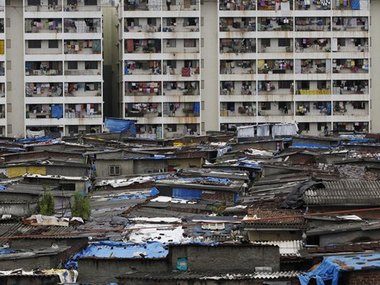There’s a new poverty statistic doing the rounds in India. According to unreleased data from the Socio-Economic Caste Census (SECC) reported in The Indian Express
on Friday, about 35 percent of urban Indian households live below the poverty line. This has been calculated on the basis of the criteria laid down by an expert group of the Planning Commission led by Prof. S R Hashim. [caption id=“attachment_1976781” align=“alignleft” width=“380” class=" “]
 Slums adjoining high rises in Mumbai. Image courtesy-Reuters[/caption] As per the statistics, the highest percentage of urban poverty is in Manipur (54.95%) while the lowest is in Goa (16%). Earlier this month,
data from the SECC
had stated that 73% of the total households were in villages, and out of these, 74% lived on a monthly income of less than Rs 5,000 of its highest earner. Poverty estimates had hit the national headlines in 2011, when the Planning Commission
told the Supreme Court
that its yardstick for calculating poverty was about Rs 32 in urban areas and about Rs 26 per day in rural areas, as per the recommendations of a panel headed by Prof Suresh Tendulkar. Going by this benchmark, only 13.7% of the population in cities was said to be poor in 2011-12. The government, had however, taken note of the outrage caused by this revelation, and said in a subsequent
press note
that several representations were made suggesting that the poverty line was too low. It further said it had constituted a new committee under Dr C Rangarajan to review the methodology for calculating poverty. The Hashim committee, on which the latest SECC figures are based, pointed out some inadequacies in earlier ways of enumerating the poor. According to it, they assumed that households who were able to meet their basic minimum food requirements were also able to meet their other requirements. “This assumption is more likely to be wrong than correct,” it said. (The report of the committee is available
here
) The committee used a three-step methodology to identify the urban poor, in which it ‘automatically excluded’ and ‘automatically included’ persons based on certain indicators, and then used a scoring index to find out the level of poverty of the remaining persons. So, for instance, people who lived in houses with four or more rooms, had a car, or an air-conditioner, were automatically held as above the poverty line. On the other hand, homeless people, those with no income from any source, or households where there was no member above 18 years of age, were automatically said to be below the line. While listing out the differences between poverty in villages and cities, the panel pointed out that urban poor work in the informal sector, characterized by a constant threat of eviction, removal, confiscation of goods and an almost non-existent social security cover. It also noted that the urban poor mostly lived in “cramped, overcrowded and often unsanitary conditions” which are prone to both natural and man-made disasters.
Slums adjoining high rises in Mumbai. Image courtesy-Reuters[/caption] As per the statistics, the highest percentage of urban poverty is in Manipur (54.95%) while the lowest is in Goa (16%). Earlier this month,
data from the SECC
had stated that 73% of the total households were in villages, and out of these, 74% lived on a monthly income of less than Rs 5,000 of its highest earner. Poverty estimates had hit the national headlines in 2011, when the Planning Commission
told the Supreme Court
that its yardstick for calculating poverty was about Rs 32 in urban areas and about Rs 26 per day in rural areas, as per the recommendations of a panel headed by Prof Suresh Tendulkar. Going by this benchmark, only 13.7% of the population in cities was said to be poor in 2011-12. The government, had however, taken note of the outrage caused by this revelation, and said in a subsequent
press note
that several representations were made suggesting that the poverty line was too low. It further said it had constituted a new committee under Dr C Rangarajan to review the methodology for calculating poverty. The Hashim committee, on which the latest SECC figures are based, pointed out some inadequacies in earlier ways of enumerating the poor. According to it, they assumed that households who were able to meet their basic minimum food requirements were also able to meet their other requirements. “This assumption is more likely to be wrong than correct,” it said. (The report of the committee is available
here
) The committee used a three-step methodology to identify the urban poor, in which it ‘automatically excluded’ and ‘automatically included’ persons based on certain indicators, and then used a scoring index to find out the level of poverty of the remaining persons. So, for instance, people who lived in houses with four or more rooms, had a car, or an air-conditioner, were automatically held as above the poverty line. On the other hand, homeless people, those with no income from any source, or households where there was no member above 18 years of age, were automatically said to be below the line. While listing out the differences between poverty in villages and cities, the panel pointed out that urban poor work in the informal sector, characterized by a constant threat of eviction, removal, confiscation of goods and an almost non-existent social security cover. It also noted that the urban poor mostly lived in “cramped, overcrowded and often unsanitary conditions” which are prone to both natural and man-made disasters.
How much of urban India is poor? Latest estimate puts it at more than one in three persons
Neerad Pandharipande
• July 17, 2015, 12:37:14 IST
According to unreleased data from the SECC reported in The Indian Express on Friday, about 35 percent of urban Indian households live below the poverty line.
Advertisement
)
End of Article